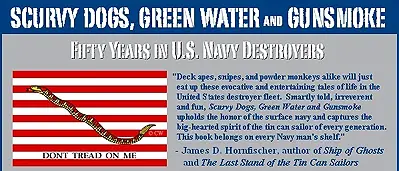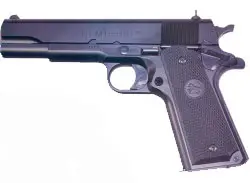 |
 |
|
Colt U.S. M1911 .45 ACP Pistol By Bob Cohen and Dave Hood  Toward the end of the 19th Century, the U.S. Navy began to look for a replacement for its aging Model 1851 Colt Navy percussion revolvers, which had been eclipsed by steady advances in technology. The U.S. Army was also looking to replace its more modern Model 1873 Colt Single Action Army, or 'Peacemaker' revolvers. Both the 1851 Navy and 1873 Army revolvers were of single action design, meaning that the hammer had to be manually cocked prior to squeezing the trigger in order to fire the weapon. Additionally, the cylinders on these revolvers did not swing out. These design features made them slow to load and slow to fire. The next generation of revolvers was the Colt 1889-1895 series, the first modern revolvers. The cylinders swung out from the frame for easy loading and the weapon could be fired by one long pull of the trigger that cocked the hammer and rotated the cylinder (double-action). While this basic design represents revolver developments still in service today, the U.S. military had some unpleasant operational experiences with the 1895 series in terms of their perceived lack of stopping power. Although this failing would properly be attributed to the caliber (.38) and ammunition rather than the mechanical design of the revolvers themselves, in 1905 the U.S. Army again began the search for a new sidearm, this time specifying .45-inch as the caliber. American gun designer John M. Browning had been developing a series of self-loading, or semi-automatic pistols, culminating with the weapon that won the competition and was subsequently adopted by all U.S. services as the U.S. Army Model of 1911. These pistols represented a completely different mechanical solution to the problem of designing a repeating handgun. In the simplest terms, a M1911 pistol has a barrel encased in a spring-loaded movable slide, with a spring-loaded magazine containing a supply of cartridges inside the pistol grip, below the barrel. When the pistol fires, the recoil drives the slide backward, opening the breech and ejecting the empty shell casing. As the springs return the slide to the original forward position, the slide strips the next cartridge from the magazine and loads it as the breech closes (self-loading) and the pistol is now ready to fire again with the next squeeze of the trigger. This cycle continues as long as there is an ammunition supply in the magazine. The Colt M1911 pistol is relatively large. It is 8� inches long by 5 inches high and weighs about 2� pounds. Standard ammunition consists of a 230-grain bullet with a velocity of 805 feet per second, effective out to a range of approximately 50 yards (the rounds are still lethal at longer ranges, but aiming becomes problematic. The Colt M1911 pistol has an undeserved reputation among novice shooters as being difficult to shoot. It is not. However, it does require a higher degree of training than the weapons it replaced and the Beretta M9 that replaced it. The M1911 is single action, meaning the hammer must be manually cocked in order to fire the first shot, after which it is self-cocking. In addition, the pistol has two external manual safety devices that must be properly manipulated by the shooter. By the end of World War Two, nearly two million M1911 pistols had been produced by a number of different manufacturers, including some not normally in the gun business, such as the Singer Sewing Machine Company. This was still not enough to meet the demand of two World Wars, so the U.S. military also employed .45-caliber revolvers produced by both Colt and Smith & Wesson; these were known as "substitute standard" weapons. In 1985, the M1911 was replaced in U.S. service by the 9x19mm Beretta M9, a modern, double action self-loading pistol. Notwithstanding issues involved in the selection of this pistol (ranging from pure politics to NATO ammunition standardization), the M1911's in use were tired after long service and needed to be replaced. However, with wartime operational experience again showing the need for a heavy pistol, .45 semi-autos have once again started to equip special units in the U.S. military and the M1911 pistol continues to have the widest and most loyal following in civilian competitive shooting sports. Note: Several articles and reviews of M1911 type pistols from Colt (M1991), Kimber, Valtro and the Springfield Armory can be found on the Guns and Shooting Online Product Review and Handgun Information pages. |
Copyright 2008 by Bob Cohen and Dave Hood. All rights reserved.
|
|